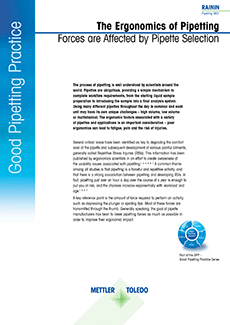 |
How to reverse pipette. |
Reverse pipetting is handy when pipetting viscous, foaming, high vapor pressure or low surface tension liquids.
A positive displacement pipette is an ideal instrument to precisely and accurately transfer these types of liquids. However, reverse pipetting provides an effective workaround when using a regular air-displacement pipette.
- Set the pipette to the desired volume.
- Depress the plunger completely – past the first stop to the second (blowout) stop.
- Immerse the tip in the liquid, and slowly release the plunger to full extension.
- Dispense by pressing to the first stop.
- A small volume of liquid will remain in the tip. Blow out this residual volume into a separate container and properly dispose of the used tip.
Note: Reverse pipetting can reduce accuracy, and precision is user-dependent.
Interested in learning more? Order your pipetting challenging liquids poster today! The poster includes a thorough visual representation of reverse pipetting and identifies various types of challenging liquids and different types of pipette tips that can help achieve accurate results when pipetting challenging liquids.









